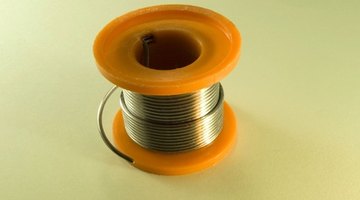How to Use Acid Solder Flux
Acid solder flux comes in two forms. It can be a brush-on additive, or it can be located inside hollow-core solder in order to automatically flux anything that you solder. In each case, the flux acts like a cleaner that dissolves the oxides on metal pieces for a tight solder fit.

Things You Will Need
- Emery paper
- Acid solder flux
- Small applicator brush
- Soldering gun or hobby torch
- Acid flux solder
Only use acid flux when joining pieces of metal together, such as copper pipes. Never use it for electronic soldering, where it will will decay and dissolve the electrical connection.
-
Clean the pieces to be soldered together by rubbing each with emery paper to remove any oxidation. This is a necessary step before you use any type of acid flux.
-
Dab on some acid flux to the cleaned parts with an applicator brush. Cover the area thoroughly, and don't skimp when applying it. This will further remove any oxidation that you may have missed when using the emery cloth.
-
Heat the area with a soldering gun, or, if you are soldering larger areas, use a hobby torch. The area to be soldered must be completely heated to the melting point of the solder.
-
Touch acid flux core solder to the joint that will be soldered, and do this repeatedly until it begins to melt. Once the melting point has been reached, press the acid flux core solder onto the joint and allow the solder to melt and flow. The acid inside the solder will keep the area from becoming carbonized during the soldering process, and it will also ensure a tight bond at the joint.
Tip
If you're using a soldering gun, "tin" the tip by rubbing a bit of solder over it until it melts.
References
Tips
- If you're using a soldering gun, "tin" the tip by rubbing a bit of solder over it until it melts.
Writer Bio
Dale Yalanovsky has been writing professionally since 1978. He has been published in "Woman's Day," "New Home Journal" and on many do-it-yourself websites. He specializes in do-it-yourself projects, household and auto maintenance and property management. Yalanovsky also writes a bimonthly column that provides home improvement advice.
Photo Credits
- reel of core solder image by Alex from Fotolia.com
- reel of core solder image by Alex from Fotolia.com
More Articles



